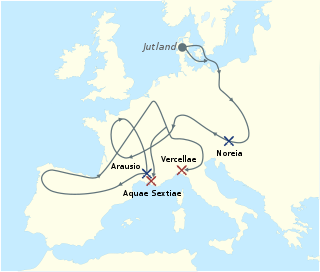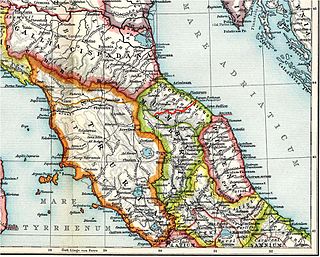This article concerns the period 229 BC – 220 BC.

This article concerns the period 59 BC – 50 BC.
This article concerns the period 79 BC – 70 BC.
Year 222 BC was a year of the pre-Julian Roman calendar. At the time it was known as the Year of the Consulship of Marcellus and Calvus. The denomination 222 BC for this year has been used since the early medieval period, when the Anno Domini calendar era became the prevalent method in Europe for naming years.

Marcus Claudius Marcellus, five times elected as consul of the Roman Republic, was an important Roman military leader during the Gallic War of 225 BC and the Second Punic War. Marcellus gained the most prestigious award a Roman general could earn, the spolia opima, for killing the Gallic military leader and king Viridomarus in single combat in 222 BC at the Battle of Clastidium. Furthermore, he is noted for having conquered the fortified city of Syracuse in a protracted siege during which Archimedes, the famous mathematician, scientist, and inventor, was killed, despite Marcellus ordering the soldiers under his command not to harm him. Marcus Claudius Marcellus died in battle in 208 BC, leaving behind a legacy of military conquests and a reinvigorated Roman legend of the spolia opima.
Gnaeus Cornelius Scipio Calvus was a Roman general and statesman during the third century BC. He played a major part in the Second Punic War, establishing Roman rule in the east of the Iberian peninsula and tying up several Carthaginian armies to keep them from reinforcing Hannibal.

The Battle of Vercellae, or Battle of the Raudine Plain, was fought on 30 July 101 BC on a plain near Vercellae in Gallia Cisalpina. A Germanic-Celtic confederation under the command of the Cimbric king Boiorix was defeated by a Roman army under the joint command of the consul Gaius Marius and the proconsul Quintus Lutatius Catulus. The battle marked the end of the Germanic threat to the Roman Republic.

The Battle of Aquae Sextiae (Aix-en-Provence) took place in 102 BC. After a string of Roman defeats, the Romans under Gaius Marius finally defeated the Teutones and Ambrones as they attempted to advance through the Alps into Italy. The Teutones and the Ambrones were defeated. Some of the surviving captives are reported to have been among the rebelling gladiators in the Third Servile War. Local lore associates the name of the mountain, Mont St Victoire, with the Roman victory at the battle of Aquae Sextiae, but Frédéric Mistral and other scholars have debunked this theory.

The Battle of Telamon was fought between the Roman Republic and an alliance of Celtic tribes in 225 BC. The Romans, led by the consuls Gaius Atilius Regulus and Lucius Aemilius Papus, defeated the Celts led by the Gaesatae kings Concolitanus and Aneroëstes. This removed the Celtic threat from Rome and allowed the Romans to extend their influence over northern Italy.

The Cimbrian or Cimbric War was fought between the Roman Republic and the Germanic and Celtic tribes of the Cimbri and the Teutons, Ambrones and Tigurini, who migrated from the Jutland peninsula into Roman-controlled territory, and clashed with Rome and her allies. The Cimbrian War was the first time since the Second Punic War that Italia and Rome itself had been seriously threatened.
Viridomarus was a Gallic military leader of the Gaesatae. In 222 BC he was hired by the Insubres who were fighting the Romans. Viridomarus led an mercenary army against a Roman army at the Battle of Clastidium. The Romans won the battle, and in the process, Marcus Claudius Marcellus, the Roman leader, earned the spolia opima by killing Viridomarus in single combat.

The Insubres or Insubri were an ancient Celtic population settled in Insubria, in what is now the Italian region of Lombardy. They were the founders of Mediolanum (Milan). Though completely Gaulish at the time of Roman conquest, they were the result of the fusion of pre-existing Ligurian and Celtic population with Gaulish tribes.
The Gaesatae or Gaesati were a group of Gallic mercenary warriors who lived in the Alps near the river Rhône and fought against the Roman Republic at the Battle of Telamon in 225 BC.
Acerrae was a city of Cisalpine Gaul, in the territory of the Insubres. Polybius describes it merely as situated between the Alps and the Po; and his words are copied by Stephanus of Byzantium: but Strabo tells us that it was near Cremona: and the Tabula places it on the road from that city to Laus Pompeia, at a distance of 22 Roman miles from the latter place, and 13 from Cremona. These distances coincide with the position of Gherra or Gera, a village, or rather suburb of Pizzighettone, on the right bank of the river Adda. It appears to have been a place of considerable strength and importance even before the Roman conquest: and in 222 BC, held out for a considerable time against the consuls Marcellus and Scipio, but was compelled to surrender after the Battle of Clastidium.

Over the course of nearly four centuries, the Roman Republic fought a series of wars against various Celtic tribes, whom they collectively described as Galli, or Gauls. Among the principal Gallic peoples described as antagonists by Greek and Roman writers were the Senones, Insubres, Boii, and Gaesatae.
Lucius Furius Purpureo was a Roman politician and general, becoming consul in the year 196 BC. Lucius Furius was from the gens Furia patrician family in Rome.

The Battle of Silva Litana was an ambush that took place in a forest 75 miles northwest of the Roman city of Ariminum during the Second Punic War in 216 BC. The Gallic Boii surprised and destroyed a Roman army under the consul-elect Lucius Postumius Albinus. Of 25,000 Romans, only 10 survived, with a few being taken prisoner by the Gauls. The corpse of Postumius was decapitated and his skull was made into a gilded ceremonial cup by the Boii. News of this military disaster probably reached Rome after the defeat at Cannae in the fall of 216 BC or the spring election of consuls for 215 BC, triggering a renewed panic. The Romans were compelled to postpone military operations against the Gauls until the conclusion of the Second Punic War, sending only two legions to guard against additional Gallic attacks. However, the Boii and Insubres did not attempt to exploit their victory. Cisalpine Gaul remained in relative peace until 207 BC, when Hasdrubal Barca arrived there with his army from Spain.
The siege of Mutina in 218 BC constitutes one of the first episodes of the Second Punic War. Hannibal's diplomacy in Cisalpine Gaul persuaded the Gallic Boii and Insubres tribes to revolt and drive the Roman colonists out of Piacenza (Placentia) and push them as far as Modena (Mutina), which was then besieged.








